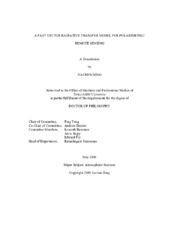| dc.description.abstract | Polarimetric remote sensing technologies have been demonstrated to be irreplaceable and effective for inferring cloud, aerosol, and ocean properties. To infer atmospheric and oceanic constituent properties from observational data, an efficient and accurate retrieval algorithm is needed. The accuracy and efficiency of the retrieval algorithm depends on the radiative transfer model (RTM) used in the forward calculations involved in implementing the retrieval algorithm.
If a radiative transfer calculation is implemented in-line as part of a retrieval algorithm, rather than simply generating and interpolating from a look-up table, the atmospheric profiles and surface properties can be directly incorporated into the retrieval system to improve accuracy. Some interpolation errors can also be avoided. However, an in-line radiative transfer calculation usually does not satisfy computational efficiency requirements for an operational remote sensing application. To fully exploit the capability of satellite polarimetric instruments, it is imperative to develop an accurate and fast vector RTM.
The reported research develops a fast vector RTM in support of atmospheric and oceanic polarimetric remote sensing. This model is capable of simulating the Stokes vector observed at the top of the atmosphere and at the terrestrial surface by considering absorption, scattering, and emission in the atmosphere and ocean. Gas absorption is parameterized in terms of gas concentration, temperature, and pressure. The parameterization scheme uses a regression method and can be easily applied to an inhomogeneous atmospheric path. An efficient two-component approach combining the small-angle approximation and the adding-doubling method is utilized to solve the vector radiative transfer equation (RTE). The thermal emission source is approximated as a linear function of optical thickness in homogeneous layers. Based on this approximation, the thermal emission component of the RTE solution can be obtained by an efficient doubling process. The air-sea interface is treated as a wind-ruffled rough surface in the model to mimic a realistic ocean surface. Several bio-optical models are introduced to model ocean inherent optical properties.
It is shown that the developed RTM can be used in a retrieval algorithm by comparing the simulation results with observations by POLDER and MODIS satellite instruments. | en |


